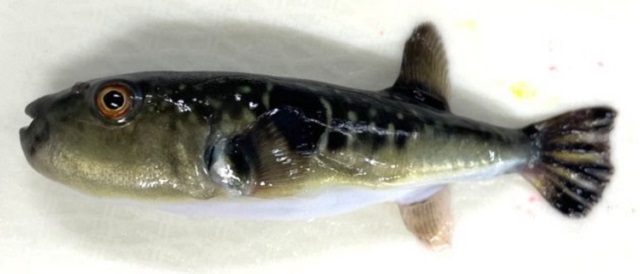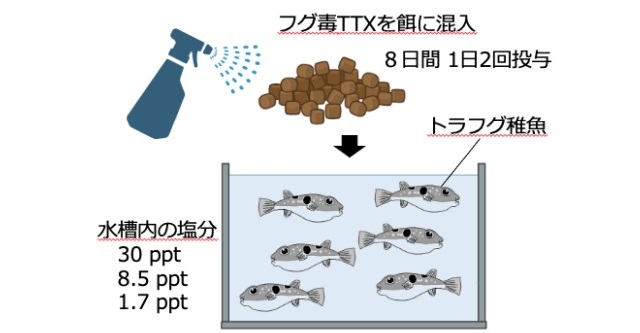
”Here, little fishies! Come get your poison!”
Fugu, as pufferfish is called in Japan, is famous for two things it can do: make your taste buds rejoice and flat-out kill you. That’s because fugu livers, ovaries, eyes, and even skin contain tetrodotoxin, a powerful neurotoxin that causes paralysis, leaving those afflicted by the poison, for which there is no known antidote, to suffocate.
However, fugu don’t produce tetrodotoxin themselves. Instead, they acquire it through eating other sea creatures that contain bacteria with tetrodotoxin in smaller amounts, developing a resistance to the harmful effects in the process. So though fugu in the wild naturally gravitate towards a diet that leads to tetrodotoxin permeating their skin and organs, if their diet from birth was limited to foods without those bacteria, you’d have non-poisonous fugu.
But what if you took some non-poisonous fugu, who’d been hatched and then raised in a research facility and were thus tetrodotoxin-free, and started feeding them tetrodotoxin? That’s the question being asked by scientists at Nagasaki University, who’ve started mixing a dose of tetrodotoxin in with the feed for a group of non-poisonous fugu.
▼ A diagram of the experiment (hopefully the spray bottle of neurotoxin is very clearly labeled so that no one mistakes it for Febreze)
To answer the most immediate question that springs to mind, the fugu haven’t died, as apparently the dosage is small enough to not be life-threatening. However, the researchers have observed changes in the composition of the fugu’s intestinal flora, i.e. their gut bacteria. These changes could also possibly affect the functions of the fugu’s gut microbiome relating to metabolizing lipids and sugars. Whether these changes have a positive or negative effect on the fugu’s wellbeing is a question the researchers say will require further study to answer.
Another question that might be springing to mind is “Why?” Why, after going to the trouble to raise non-poisonous pufferfish, would you think “OK, let’s poison these guys up!”? The goal is to better understand fugu physiology in order to apply that knowledge to aquaculture. Though non-toxic fugu were first bred more than 20 years ago (also by scientists at Nagasaki University), farm-raised fugu is yet to really catch on among foodies, leaving demand for the fish to be supplied almost entirely on wild catches. Being able to more effectively raise fugu, with a flavor replicating that of wild-caught fish, could lessen the environmental impact of the pufferfish-eating practice.
The researchers say they should have further results ready for public announcement next summer.
Source: TBS News Dig via Jin, Nagasaki University
Images: Nagasaki University
● Want to hear about SoraNews24’s latest articles as soon as they’re published? Follow us on Facebook and Twitter!


 Treat Yourself to this Japanese Delicacy if You Dare – Ovaries From a Poisonous Fish!
Treat Yourself to this Japanese Delicacy if You Dare – Ovaries From a Poisonous Fish! Aichi supermarket caught selling poisonous puffer fish livers, “been selling it for decades”
Aichi supermarket caught selling poisonous puffer fish livers, “been selling it for decades” Nagoya man hospitalized after eating fish with name including “fugu,” a.k.a. “poisonous blowfish”
Nagoya man hospitalized after eating fish with name including “fugu,” a.k.a. “poisonous blowfish” 10-year-old Japanese girl is youngest person ever certified to prepare deadly poisonous blowfish
10-year-old Japanese girl is youngest person ever certified to prepare deadly poisonous blowfish We eat fugu pufferfish semen at a Japanese restaurant in Tokyo
We eat fugu pufferfish semen at a Japanese restaurant in Tokyo Rakuten randomly offers 58 New Year’s osechi feasts in Japan, but did we get a star or a dud?
Rakuten randomly offers 58 New Year’s osechi feasts in Japan, but did we get a star or a dud? The Purple Lucky Bag from Village Vanguard is an extra-large waste of money
The Purple Lucky Bag from Village Vanguard is an extra-large waste of money Majority of Japanese mayors say foreign residents are essential but most see good and bad effects
Majority of Japanese mayors say foreign residents are essential but most see good and bad effects Starbucks Japan ready to get Year of the Horse started with adorable drinkware and plushies【Pics】
Starbucks Japan ready to get Year of the Horse started with adorable drinkware and plushies【Pics】 New Japanese menstrual product seeks to help women spot unidentified iron deficiencies
New Japanese menstrual product seeks to help women spot unidentified iron deficiencies 7-Eleven Japan has a hack for creating insanely delicious potato chip rice meals
7-Eleven Japan has a hack for creating insanely delicious potato chip rice meals Kyoto samurai house wants to share its history of seppuku, torture and gold coins with visitors
Kyoto samurai house wants to share its history of seppuku, torture and gold coins with visitors Japan’s first hotel with a human washing machine is now ready for you to come and bathe in it
Japan’s first hotel with a human washing machine is now ready for you to come and bathe in it The new Pikachu and Psyduck donuts are here! Taste-testing the Mister Donut Pokémon sweets【Photos】
The new Pikachu and Psyduck donuts are here! Taste-testing the Mister Donut Pokémon sweets【Photos】 Tokyo event lets you travel back in time, for free, to celebrate 100 years since Showa era start
Tokyo event lets you travel back in time, for free, to celebrate 100 years since Showa era start Hayao Miyazaki says Happy New Year to Studio Ghibli fans with new art for Year of the Horse
Hayao Miyazaki says Happy New Year to Studio Ghibli fans with new art for Year of the Horse Japanese beef bowl chain Sukiya’s 2026 Smile Box lucky bag basically pays for itself
Japanese beef bowl chain Sukiya’s 2026 Smile Box lucky bag basically pays for itself We found possibly the quietest Japanese-style hotel in Tokyo’s bustling Shinjuku district
We found possibly the quietest Japanese-style hotel in Tokyo’s bustling Shinjuku district Cup Noodle tries an authentic Jiro-style ramen, but something’s not quite right
Cup Noodle tries an authentic Jiro-style ramen, but something’s not quite right The best Starbucks Japan Frappuccinos we want to drink again in 2026
The best Starbucks Japan Frappuccinos we want to drink again in 2026 We revisited Sweets Paradise after a decade to see if Japan’s dessert buffet still delivers
We revisited Sweets Paradise after a decade to see if Japan’s dessert buffet still delivers That time Seiji called JASRAC to ask why he didn’t get paid royalties for his song being on TV
That time Seiji called JASRAC to ask why he didn’t get paid royalties for his song being on TV Japan’s oldest largetooth sawfish in captivity back on display in Mie Prefecture
Japan’s oldest largetooth sawfish in captivity back on display in Mie Prefecture Pizza Hut Japan’s hot lucky bags are perfect for a New Year’s pizza party
Pizza Hut Japan’s hot lucky bags are perfect for a New Year’s pizza party 7-Eleven Japan starts new temporary luggage storage service in over 300 branches
7-Eleven Japan starts new temporary luggage storage service in over 300 branches Disillusionment at Tsukiji’s tourist-target prices led us to a great ramen restaurant in Tokyo
Disillusionment at Tsukiji’s tourist-target prices led us to a great ramen restaurant in Tokyo Starbucks teams up with 166-year-old Kyoto doll maker for Year of the Horse decorations【Photos】
Starbucks teams up with 166-year-old Kyoto doll maker for Year of the Horse decorations【Photos】 Tokyo considering law requiring more trash cans following litter increase in heavily touristed area
Tokyo considering law requiring more trash cans following litter increase in heavily touristed area Tokyo’s Tsukiji sushi neighborhood asks tour groups to stay away for the rest of the month
Tokyo’s Tsukiji sushi neighborhood asks tour groups to stay away for the rest of the month Japan may add Japanese language proficiency, lifestyle classes to permanent foreign resident requirements
Japan may add Japanese language proficiency, lifestyle classes to permanent foreign resident requirements Sanrio theme park in Japan announces plans to expand into a Sanrio resort
Sanrio theme park in Japan announces plans to expand into a Sanrio resort Stamina-destroying “Paralysis Noodles” are Tokyo’s newest over-the-top ramen innovation
Stamina-destroying “Paralysis Noodles” are Tokyo’s newest over-the-top ramen innovation Survey asks foreign tourists what bothered them in Japan, more than half gave same answer
Survey asks foreign tourists what bothered them in Japan, more than half gave same answer Japan’s human washing machines will go on sale to general public, demos to be held in Tokyo
Japan’s human washing machines will go on sale to general public, demos to be held in Tokyo Japan’s deadliest food claims more victims, but why do people keep eating it for New Year’s?
Japan’s deadliest food claims more victims, but why do people keep eating it for New Year’s? We deeply regret going into this tunnel on our walk in the mountains of Japan
We deeply regret going into this tunnel on our walk in the mountains of Japan Studio Ghibli releases Kodama forest spirits from Princess Mononoke to light up your home
Studio Ghibli releases Kodama forest spirits from Princess Mononoke to light up your home Major Japanese hotel chain says reservations via overseas booking sites may not be valid
Major Japanese hotel chain says reservations via overseas booking sites may not be valid Put sesame oil in your coffee? Japanese maker says it’s the best way to start your day【Taste test】
Put sesame oil in your coffee? Japanese maker says it’s the best way to start your day【Taste test】 No more using real katana for tourism activities, Japan’s National Police Agency says
No more using real katana for tourism activities, Japan’s National Police Agency says Starbucks Japan reveals new sakura drinkware collection, inspired by evening cherry blossoms
Starbucks Japan reveals new sakura drinkware collection, inspired by evening cherry blossoms Updated cherry blossom forecast shows extra-long sakura season for Japan this year
Updated cherry blossom forecast shows extra-long sakura season for Japan this year Picture of a pufferfish vomiting water is the Japanese Internet’s newest darling
Picture of a pufferfish vomiting water is the Japanese Internet’s newest darling
Leave a Reply